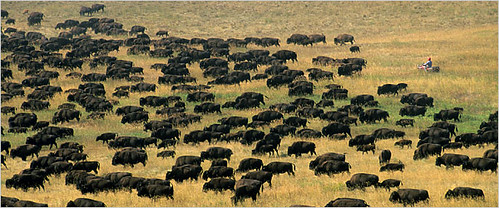Bison have made a comeback after nearly going extinct more than 100 years ago. However, existing bison were preserved by ranchers, who frequently hybridized them with their cattle.
"They purposely crossed bison with domestic cattle to make a better beef animal," which they called cattelo, said James Derr, a geneticist at the Texas A&M College of Veterinary Medicine. "Bison did better in harsh conditions and are more resistant to parasites and native viral diseases." For example, bison do not contract Texas fever which afflicts cattle.
Even though these hybrids carry a mixture of cattle and bison DNA, they look like bison, which means that their impure DNA has spread throughout much of the surviving bison population. Because fewer than 10,000 American bison are pure-blooded, this is causing problems with conservation efforts, since hybrids could suffer serious consequences such as changes in behavior or traits such as weight gain and fertility, in addition to disease resistance.
"Hybridization makes it hard to predict and hard to manage because their immune response can be all over the place," Dr. Derr said.
Unhybridized bison are crucial to efforts to restore large tracts of native prairie and plains that include herds of bison. Additionally, establishing new and distinct bison herds will help assure the future of the wild bison.
To prevent a "genomic extinction" of bison through hybridization, biologists are focusing on the protection and perpetuation of the herds with pure or nearly pure genetics.
The new approach may change other aspects of management, as agencies move from managing the species to managing the genetics. Dr. Derr is involved in a study, for instance, of whether the hunting of the bison that leave Yellowstone might be selecting certain behaviors from the population because animals that migrate are targeted.
Cited story.

